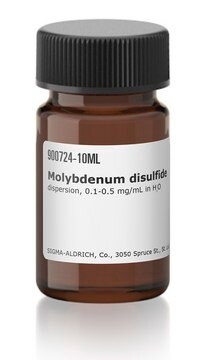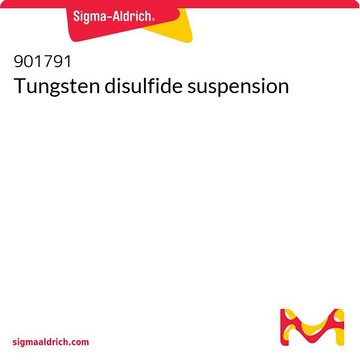901867
Molybdenum disulfide ink for spin/spray coating
Synonym(s):
MoS2 dispersion, MoS2 ink
About This Item
Recommended Products
description
Resistivity: 75-100 kΩ·cm; Prepared by spin-coating at 1000 rpm/30 s for 1 coat, followed by thermal annealing at 400°C in Ar/H2 for 3 hours
form
dispersion
composition
Solid Content, 1.5-2.5%
greener alternative product characteristics
Design for Energy Efficiency
Learn more about the Principles of Green Chemistry.
sustainability
Greener Alternative Product
color
green
particle size
≤0.4 μm
viscosity
2-4 mPa.s
bp
78 °C (Ethanol)
density
0.78-0.88 g/mL at 25 °C
greener alternative category
, Enabling
SMILES string
[Mo]=S=S
InChI key
IZCXEXNUAYYFRY-UHFFFAOYSA-N
General description
Application
Legal Information
Signal Word
Danger
Hazard Statements
Precautionary Statements
Hazard Classifications
Eye Dam. 1 - Flam. Liq. 2 - Skin Irrit. 2
Storage Class Code
3 - Flammable liquids
WGK
WGK 1
Flash Point(F)
55.4 °F - closed cup
Flash Point(C)
13.0 °C - closed cup
Choose from one of the most recent versions:
Certificates of Analysis (COA)
Don't see the Right Version?
If you require a particular version, you can look up a specific certificate by the Lot or Batch number.
Already Own This Product?
Find documentation for the products that you have recently purchased in the Document Library.
Customers Also Viewed
Articles
Professor Ebrahimi and Professor Robinson (Pennsylvania State University, USA) summarize recent advances in the synthesis of these 2D materials, resulting material properties, and related applications in biosensing of neurotransmitters, metabolites, proteins, nucleic acids, bacterial cells, and heavy metals.
Global Trade Item Number
| SKU | GTIN |
|---|---|
| 901867-10ML | 4061834898719 |
Our team of scientists has experience in all areas of research including Life Science, Material Science, Chemical Synthesis, Chromatography, Analytical and many others.
Contact Technical Service










